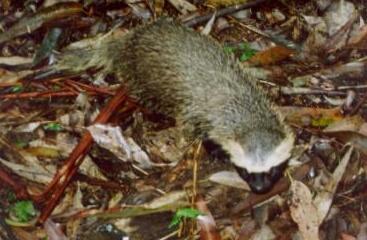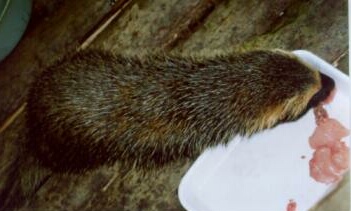|
|
|
|
 The "Furao" lives free in the 132 Hectars Castanheiras farm |
 After a couple of days in the forest they get a 'treat |
|
Lesser Grison (Galictis cuja)
Range and Habitat
.The lesser grison ranges in central and southern South America. They are found in southern Peru, western Bolivia, central Chile, Paraguay, Uruguay, Argentina, and eastern to southeastern Brazil. They are found in a wide variety of habitats, ranging from forests to open terrain from sea level to 4200 m. They frequently live near a water source. Physical
Appearance
Grisons
are similar to weasels (Mustela genus) in their appearance. Smaller
than the related greater grison (Galictis vittata). They have a long
body set on short, thick legs. They have five toes on each foot. The
toes are webbed for about 3/4 of their length, and have strong, short
curved claws. The heels are furred but the soles of the feet are naked.
They have a rounded head, long thick neck, short muzzle, and small ears
set low on the sides of the head. The tail is bushy and relatively
short, but longer in proportion to its body length (about 40% of its
head and body length) than G. vittata. Grisons are slightly stockier
than their weasel relatives.Grisons are characterized by their unique coloration. Their coarse fur is primarily a grizzled grey color with yellowish undercoat, with a black underbody, legs and face, and a white "headband" that starts at the forehead and trails back toward the ears, disappearing around the shoulder area. . Sexual dimorphism is predominant in this species, with the males being significantly larger than the females.. Diet
.The diet of the lesser grison includes small mammals (rats, rabbits, guinea pigs), birds, eggs, small reptiles, amphibians, invertebrates, and fruit. . Reproduction
and Life Cycle
.The mating habits of this species are not documented. Most mustelids are polygynous, and females are stimulated ovulators and have a period of delayed implantation. It is unknown if that occurs in this species. After gestation of approximately 39 days, an average of 2-4 kits are born in March, August, September and October. Parental behavior is not documented. . Behavior
.Grisons prefer to live under tree roots or rocks, in hollow logs, or in a burrow made by another animal. They are good climbers and swimmers, and are active both during the day and night. Grisons are solitary hunters but can be found in small groups of 2-3 individuals. They are reported to be easily tamed and have been kept as pets in Chile, where they were used to hunt chinchillas. . Like many other mustelids, they can secrete a pungent odor from their anal glands when stressed. They are noted by native people for their ferocity. . Threats
.The lesser grison does not appear to be threatened, but it has not been studied extensively enough to have its status determined appropriately. Local laws vary in regards to their protection. They exist in national parks where it is illegal to hunt game, and in Chile they have been protected since 1929. |
|
|
|
|